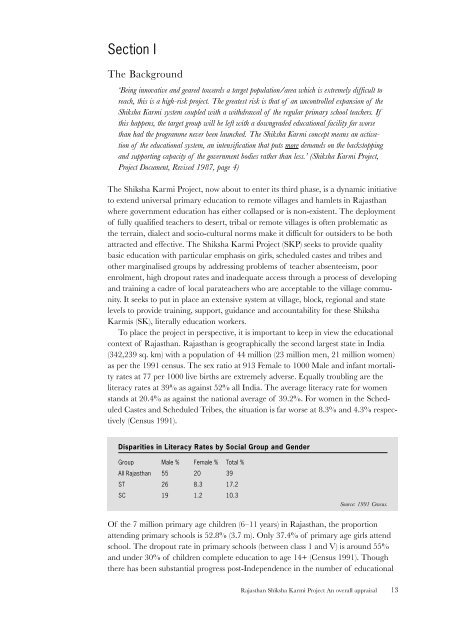Rajasthan Shiksha Karmi Project An overall appraisal
Rajasthan Shiksha Karmi Project An overall appraisal
Rajasthan Shiksha Karmi Project An overall appraisal
You also want an ePaper? Increase the reach of your titles
YUMPU automatically turns print PDFs into web optimized ePapers that Google loves.
Section IThe Background‘Being innovative and geared towards a target population/area which is extremely difficult toreach, this is a high-risk project. The greatest risk is that of an uncontrolled expansion of the<strong>Shiksha</strong> <strong>Karmi</strong> system coupled with a withdrawal of the regular primary school teachers. Ifthis happens, the target group will be left with a downgraded educational facility far worsethan had the programme never been launched. The <strong>Shiksha</strong> <strong>Karmi</strong> concept means an activationof the educational system, an intensification that puts more demands on the backstoppingand supporting capacity of the government bodies rather than less.’ (<strong>Shiksha</strong> <strong>Karmi</strong> <strong>Project</strong>,<strong>Project</strong> Document, Revised 1987, page 4)The <strong>Shiksha</strong> <strong>Karmi</strong> <strong>Project</strong>, now about to enter its third phase, is a dynamic initiativeto extend universal primary education to remote villages and hamlets in <strong>Rajasthan</strong>where government education has either collapsed or is non-existent. The deploymentof fully qualified teachers to desert, tribal or remote villages is often problematic asthe terrain, dialect and socio-cultural norms make it difficult for outsiders to be bothattracted and effective. The <strong>Shiksha</strong> <strong>Karmi</strong> <strong>Project</strong> (SKP) seeks to provide qualitybasic education with particular emphasis on girls, scheduled castes and tribes andother marginalised groups by addressing problems of teacher absenteeism, poorenrolment, high dropout rates and inadequate access through a process of developingand training a cadre of local parateachers who are acceptable to the village community.It seeks to put in place an extensive system at village, block, regional and statelevels to provide training, support, guidance and accountability for these <strong>Shiksha</strong><strong>Karmi</strong>s (SK), literally education workers.To place the project in perspective, it is important to keep in view the educationalcontext of <strong>Rajasthan</strong>. <strong>Rajasthan</strong> is geographically the second largest state in India(342,239 sq. km) with a population of 44 million (23 million men, 21 million women)as per the 1991 census. The sex ratio at 913 Female to 1000 Male and infant mortalityrates at 77 per 1000 live births are extremely adverse. Equally troubling are theliteracy rates at 39% as against 52% all India. The average literacy rate for womenstands at 20.4% as against the national average of 39.2%. For women in the ScheduledCastes and Scheduled Tribes, the situation is far worse at 8.3% and 4.3% respectively(Census 1991).Disparities in Literacy Rates by Social Group and GenderGroup Male % Female % Total %All <strong>Rajasthan</strong> 55 20 39ST 26 8.3 17.2SC 19 1.2 10.3Source: 1991 Census.Of the 7 million primary age children (6–11 years) in <strong>Rajasthan</strong>, the proportionattending primary schools is 52.8% (3.7 m). Only 37.4% of primary age girls attendschool. The dropout rate in primary schools (between class 1 and V) is around 55%and under 30% of children complete education to age 14+ (Census 1991). Thoughthere has been substantial progress post-Independence in the number of educational<strong>Rajasthan</strong> <strong>Shiksha</strong> <strong>Karmi</strong> <strong>Project</strong> <strong>An</strong> <strong>overall</strong> <strong>appraisal</strong>13












